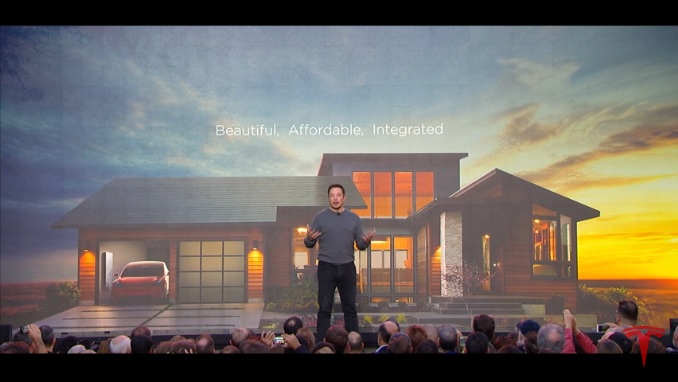
Tesla’s Elon Musk unveiled the new solar roof tiles at an event held on the set of former US TV drama Desperate Housewives in Los Angeles, where several homes had been fitted with a range of the new tiles.
Tesla and SolarCity have unveiled the much-anticipated Solar Roof system, a building integrated photovoltaics (BIPV) residential system comprised of a range of different tile formats, colours and coatings to replicate common conventional tile formats.
The joint collaboration will be targeted towards both the new build and retrofit housing markets, with the production processes used to make the “snowflake” tiles meaning no two roofs will be the same.
The solar roof is offered in four styles – textured glass tile, slate glass tile, tuscan glass tile, and smooth glass tile – which complement a variety of popular architectural styles.
Different techniques have been developed to achieve a near identical look to different tiles that include individual imbedded (125mm x 125mm) mono c-Si solar cells. The result is the ability of the tiles from high angles to be transparent, allowing sunlight to reach the cell, while appearing opaque from low or street-level viewpoints to replicate a conventional roof.

Dark shaded tiles are solar cells. Image: Tesla/SolarCity
A French slate style solar tile uses a hydrographic film printing process on the glass to create unique individual tile patterning.
Speaking at a launch event on Friday 28 October, Tesla chief executive Elon Musk explained that BIPV system was intended to make solar panels as appealing to consumers as electric cars have become.
“The goal is to have solar roofs that look better than normal roofs, generate electricity, last longer, have better insulation and have an installed cost that is less than a normal roof plus the cost of electricity,” he said. “Why would you buy anything else?”
Although BIPV systems are not new they have followed two general trends that still concern residential owners over aesthetics. BIPV systems using a ‘tile’ or ’shingle’ design are still viewed as ‘artificial’ in look, while standard modules (c-Si and thin film) employed with a sunken backplane suffer from having to be placed within the boundaries of the roofing area displacing conventional tiles.
The new Tesla/SolarCity offering hopes to overcome these barriers, offering an authentic tile roof aesthetic but with the benefits of a home solar system linked to a Tesla Powerwall storage system and electric vehicle charger. Musk referred to this as “an obvious three part solution”.
The product offering is reported to be rolled out as early as next summer although it remains unclear when the solar roof system will be available in the UK.
Companies included Romag, Kingspan and Solarcentury, which recently launched its new Sunstation system, have all tried to crack the UK BIPV market with aesthetics considered to be a key issue for homeowners when considering solar panels.
Research by Solarcentury last year which found that 86% of homeowners surveyed want new additions to their home to ‘look stylish’. Two thirds (65%) said that if they installed solar panels they’d have to be less visible and not stand out, while a third (32%) said it was important what their neighbours think about new additions to their home.
The future deployment of the new Tesla product offering could be impacted by the outcome of an upcoming vote on the company’s attempt to acquire SolarCity, which is run by Musk’s cousins and where the Tesla CEO is the biggest shareholder.
The deal has been questioned repeatedly as SolarCity remains a loss-making business, with suggestions that Musk is hoping to rescue the company through the acquisition. A vote on the acquisition is due on 17 November.
Additional reporting by Mark Osborne.

